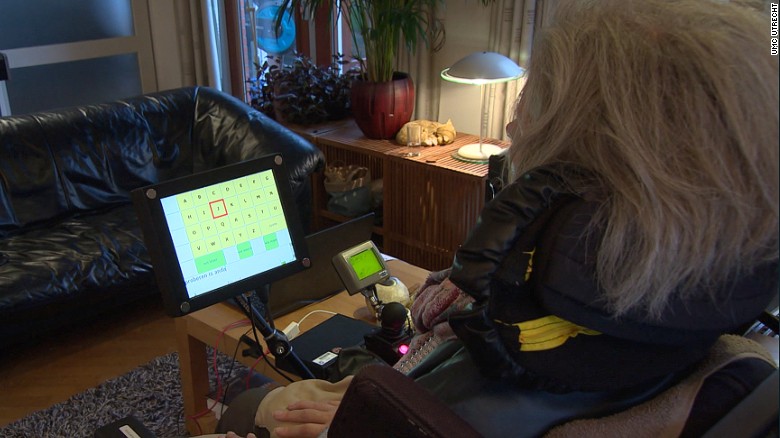The implant for the first time helped a completely paralyzed woman to communicate.

In medicine, unfortunately, there are very severe cases of paralysis, when a person is conscious, but can neither move nor speak. Patients of this kind are completely unable to communicate, they can only think. And just the mind of such people in most cases is clear, people are aware of their position and situation. Now scientists have developed an implant for the human brain, which allows paralyzed patients to communicate via computer. Man’s thoughts are transformed into words and whole sentences. In this case, patients do not need the mediation of a doctor.
“This is the world's first implantable system that works without the need for assistance from doctors,” says neuroscientist and project manager Nick Ramsay from the University of Utrechsky School of Medicine. The implant has recently been tested in a clinical setting. The first person to receive such a system was Hanneke de Bruijne. In 2008, she was diagnosed with amyotrophic lateral sclerosis (ALS), and now she is completely paralyzed.
ALS is a slowly progressive, incurable degenerative disease of the central nervous system, in which both the upper (motor cortex of the brain) and lower (anterior horns of the spinal cord and cranial nerve nuclei) lesion of the neurons are affected, resulting in paralysis and subsequent muscle atrophy. It is characterized by a progressive lesion of motor neurons, accompanied by paralysis (paresis) of the limbs and muscle atrophy.
')
The patient still had the opportunity to control the muscles of the eyeballs, that is, to move the eyes. During the meeting with the author of the project, she retained this ability and breathed on her own, without a system of artificial lungs. Two years later, the ability to breathe was lost by her, so that her life is saved by a respirator. However, the eye muscles are still working, although this is only temporary. Not long ago, the patient had a communication system installed that works by tracking the movements of her eyes.
Nick Ramsey decided to develop a system whose operation does not depend on the movement of the patients' eyes or any other motor activity. For example, Stephen Hawking, also affected by amyotrophic lateral sclerosis, works with a device that tracks the movements of the muscles of his cheek.
Such a system, according to a specialist, can only be a device that is able to monitor the electrical activity of the brain. The project leader talks about such a device as a system that reads thoughts. In general, you can say so. Various implants that read the activity of brain cells have been around for a long time. For example, such systems are used to create bionic prostheses that replace people with their own limbs.

But here we are talking about a device that should help the patient not to make movements with a prosthesis, but to demonstrate his thoughts. And Ramsey and colleagues immediately decided to create a system that could work not only in a clinical setting, but also at home, without any help. The main working element of such a system is an implant, which is surgically implanted into the human brain. This part of the computer system has two electrodes. They are implanted in the area of the cerebral cortex that controls the movement of a person. Accurate electrode placement is critical. One of them is located in the part of the cerebral cortex that is responsible for the movements of the right hand. And the second - in the area that is activated only when a person starts the countdown.
These electrodes are connected to a transmitter implanted in the patient’s shoulder. He sends data to a computer located in front of the patient, who has the ability to monitor everything that happens on the screen.
When the patient looks at the display, she sees a virtual square moving by letters. As soon as the square passes by the letter that she needs, the woman mentally represents the movement of her right hand, pressing on this letter. Her brain is quite capable of generating a signal that in a normal situation is fed into the muscles of the arm. This electrical signal is captured by the transmitter and sent to the computer. The letter marked by the patient is highlighted. Words are formed from letters, from words - sentences. The system almost does not make mistakes, its accuracy is about 95%.
“Using such a system is a slow process. Writing a word can take a few minutes. But the patient is training and the work is going faster, ” said one of the study participants. He also added that before a woman had to choose a letter for about 50 seconds. Now it takes her only 20 seconds.
This system, according to its developers, is much more reliable than the previous one, which reads eye movements. The fact is that in bright sunlight the sensor does not work, and a paralyzed woman loses the ability to communicate. But the new system works in any light.
“Now I can communicate outside the home, when my eye movement tracking system is not working. I feel more independent and self-confident when I'm on the street, ”says Bruigene.
Of course, the system needs to undergo many more tests before it is approved and developers can provide it to other people. In addition, the authors of the project are going to add the number of electrodes and improve the signal processing system. This, they said, will speed up the process of communication.
The results of their work, scientists outlined in the New England Journal of Medicine.
Source: https://habr.com/ru/post/399247/
All Articles